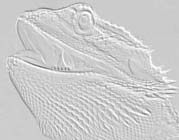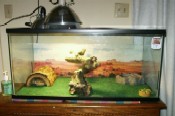 |
 |
||||||||||||||
 |
|||||||||||||||
|
Heating
& Lighting I do not recommend using hot rocks as they are potentially dangerous! They can overheat and produce serious burns or short out and produce electrical shocks. Also, Beardies do not have heat sensors on the underside of their bellies so they don't realize they're being burned. This can result in some pretty nasty burns. As
far as I know, there are only two types of bulbs that actually produce
UVB - mercury vapor and fluorescent tubes (remember to replace your
fluorescent tubes every 6 months, even if the bulb is still working).
Don't be mislead by "full spectrum" bulbs. "Full spectrum"
does not mean that it produces UVB. Beardies synthesize vitamin D3 when
exposed to UVB, and D3 is necessary for calcium metabolization. In the
wild, Beardies expose themselves to the natural UVB in the sun's rays,
but in captivity, especially in colder climates, they just don't get
as much sunlight as they need to produce enough D3. Beardies who are
deprived of UVB develop MBD (Metabolic Bone Disease) where the Beardie
uses calcium out of it's own bone sources to fuel bodily processes.
If the MBD isn't treated early, skeletal deformities, broken bones,
kidney failure, seizures, and eventually death will occur. Please see
our article on MBD. Natural
sunlight is the best. Try to get your Dragon outside when the temperature
is good and the sun is shining. Don't place your Beardie in a glass
cage in direct sunlight as you will overheat him and could kill him.
The glass of the aquarium acts like a magnifying glass in the sun -
it will heat up the tank very quickly. Always provide a shady area for
your Beardie to escape the heat of the sun if he gets too warm. If the temperature drops below 65 degrees in your home at night, you might want to consider a nighttime heat source for your Beardie. You can not use a bright light of any kind for heat at night. Imagine trying to sleep with the lights on! You wouldn't sleep very well. Your Beardie could get stressed out, stop eating, develop behavorial abnormalities, and deressed immune function if you keep his lights on all the time. Nocturnal reptile heat bulbs produce a dim light which is usually available in blue, purple (black light) and red. Some night lights produce more light at higher wattages. I don't recommend using these bulbs on a permanent basis because it is believed that beardies can still detect some light that they are emitting. The best heat source for night time is a ceramic heating element (CHE). CHE's are non-light emitting heating units. They get very hot but disperse heat over a very narrow (15" in diameter) and shallow area. The range for a 60 watt CHE is 8" down, the range for a 100 watt CHE is 10" down, the range for a 150 watt CHE is 12" down, and the range for a 250 watts is 14" down. CHE's are not effective in heating large enclosures, and a rheostat or dimmer switch may be used for small enclosures so it doesn't get too hot. It is very important that CHE's only be used in porcelain/ceramic light sockets as the amount of heat that they produce is enough to melt regular plastic light sockets. Housing |
|||||||||||||||
| Below are a few photos of my beardies homes. (Click on the image in enlarge.) | |||||||||||||||
 |
 |
||||||||||||||
 |
|||||||||||||||
|
The
Beardie Condo
|
Ojay's
simple set-up
|
||||||||||||||
|
Substrates In their native environment, Beardies live in sandy desert areas. Playground sand is often used because it is relatively dust free and easy to maintain, although there have been reports of intestinal impaction. We do not use sand of any kind and do not recommend it. Substrates we use or have used in the past include wheat bran (pest free, and rated for human consumption), outdoor carpeting, non-stick padded shelf liner, and paper towels. Substrates that I would not recommend using are: sand, corn cob, walnut shells, alfalfa pellets, kitty litter, or wood shavings. Corn cob is not digestible and is large enough to create impactions, requiring surgery. Walnut shells and kitty litter are also not digestible and have sharp edges. Water
& Food You must feed very small prey to baby Beardies. The rule-of-thumb for feeding Beardies says not to feed anything larger that the space between the Beardie's eyes. When fed prey that is too large for them, serious physical problems can result including: partial paralysis, seizures, ataxia (loss of motor control), inability to self-feed, gut impaction, and even death. Start with feeding small crickets and gradually increase to larger sizes as the Beardie grows.Also offer a daily mixture of greens and veggies for your growing Beardie. Beardies that were raised with greens as a part of their diet are more likely to enjoy greens as an adult. Please see my page on Nutrition for more info on what you can and should not feed your Beardie. Beardies consume a wide variety of invertebrates and small vertebrates in the wild, and a variety of protein sources should be offered in captivity. Prey items such as appropriately sized crickets, cockroaches, mealworms, superworms, silkworms, and wax worms can be fed. If you feed freshly molted supers or mealworms, that will reduce the amount of tough, indigestible exoskeleton. Exoskeletons (chitin) can cause intestinal impaction so the least amount ingested the better. As the Beardie reaches adulthood, you can feed less live prey and more vegetarian-based diet as the Beardie's body no longer requires the high protein diet to grow. Adult Beardies need approx. 50 - 75% vegetarian to 25 - 50% live prey/protein. Remember to dust crickets and worms with a calcium supplement just before feeding them to your Beardie. Adults don't require as much calcium supplementation as growing beardies and egg-producing females. Also, don't forget to use a multivitamin supplement a few times a week. Make a home for your crickets out of a 10 gallon aquarium or plastic container, and furnish it with pieces of egg crate or cardboard cores from paper towels and toilet paper. Pieces of fruits and vegetables, as well as food such as high-protein baby cereal mixed with reptile vitamins, tropical fish flakes, and rodent chow, all make suitable foods. Since smaller crickets are more nutritious than larger crickets (proportionately less exoskeleton) it is better to feed more of the smaller ones than fewer of the big ones. Please see my page on how to take care of live prey. Plant matter includes a variety of chopped up vegetables and fruits such as collard and mustard greens, green beans, orange-fleshed squash, escarole, dandelion greens, raspberries, mango, and cantaloupe. Feed fruit less often than veggies and greens because of the higher sugar content in fruit. See my Nutrition Content page for more info. It is not wise to feed your Beardie in the evening close to bed time as food will sit in his stomach overnight and could rot. Generally, I don't feed anything to my beardies at least two hours before bedtime. Cage Cleaning I recommend the following cleaning/disinfecting products: Nolvasan (odors are not harmful) and bleach (odors are harmful!). Do not mix the two chemicals. Dilute bleach to a solution of 10% bleach and 90% water for a super strong disinfectant. Anything you spray with bleach must be rinsed well with water and free of any bleach odors before allowed to be returned to your Beardies cage. New cage furnishings such as branches from your yard or rocks should be thoroughly cleaned before added to the enclosure. To clean a branch or rock, soak it in the bleach solution for 30 minutes then bake in the oven at 250 degrees until nice and dry. Heating the wood will kill anything that the bleach happened to miss. It is a good idea to remove feces everyday as Beardies are notorious for tromping through their poop and getting it everywhere. Also, chage the substrate at least once a month or as needed. Handling Behaviors Arm waving
Head bobbing Push-ups Beard
displaying Digging Circling
and chasing Tail up
in the air or tail twitching Gaping
Eye Bulging Hissing
|
|||||||||||||||
| Bath
Time Bathing is an important part in keeping a healthy dragon. Regular bathing helps keep the beardie hydrated, clean, and helps to relax the muscles thus making it easier for them to go to the bathroom. |
|||||||||||||||
 |
Make sure that the bath water is warm to the touch (95-99º F) and fill it full enough to reach their shoulders. Remember if it feels too warm to you then it's definately too hot for them. Some beardies are comfortable bathing in the sink or the bath tub and others may not like bath time at all. You can try placing a see through Rubbermaid container on your countertop and gently placing your beardie inside. He may feel more comfortable resting on your hand while it is submerged in the water. Or you could try rolling up a wash cloth and letting him rest his arms on it. They need to feel secure or they will never enjoy bath time. And get ready to pick your beardie out of the bath water should he decide to poop in it. NEVER LEAVE YOUR BEARDIE UNATTENDED! |
||||||||||||||
|
Copyright
© Beautiful Dragons. All Rights Reserved.
This website may not be copied or reproduced without my permission. |
|||||||||||||||